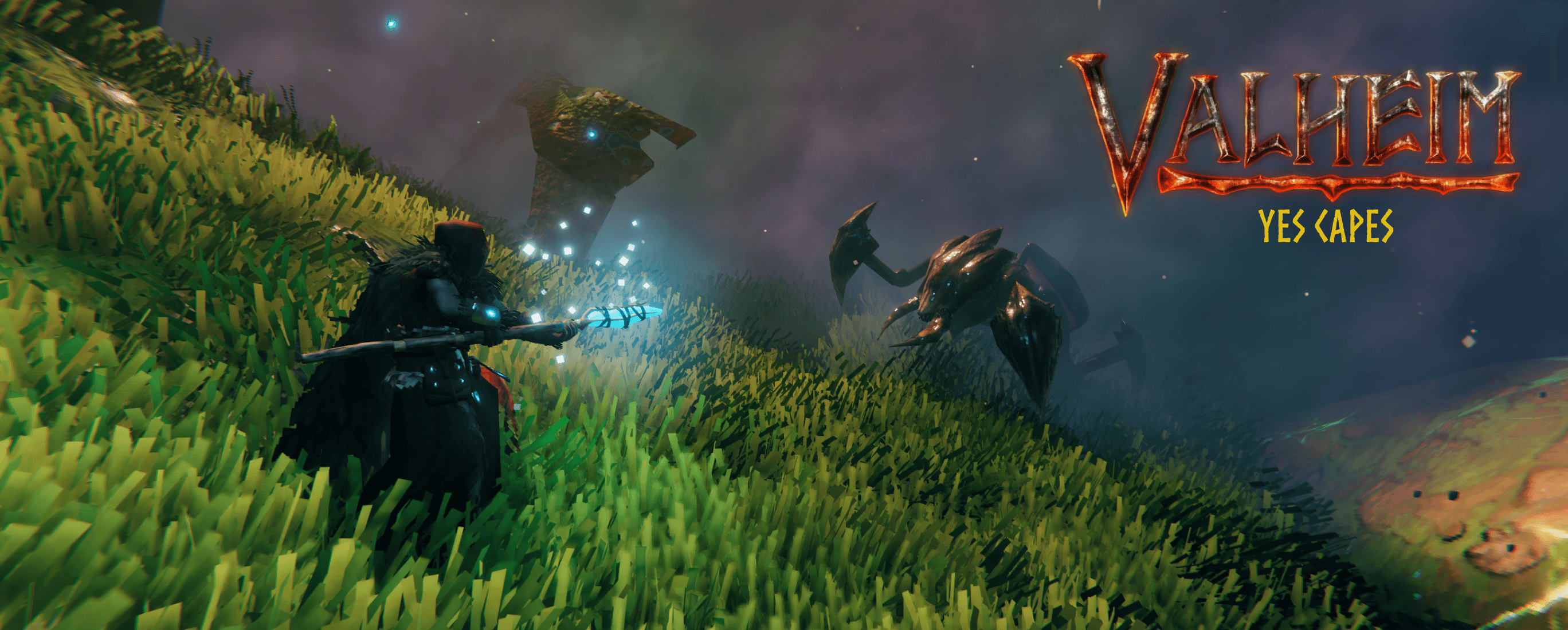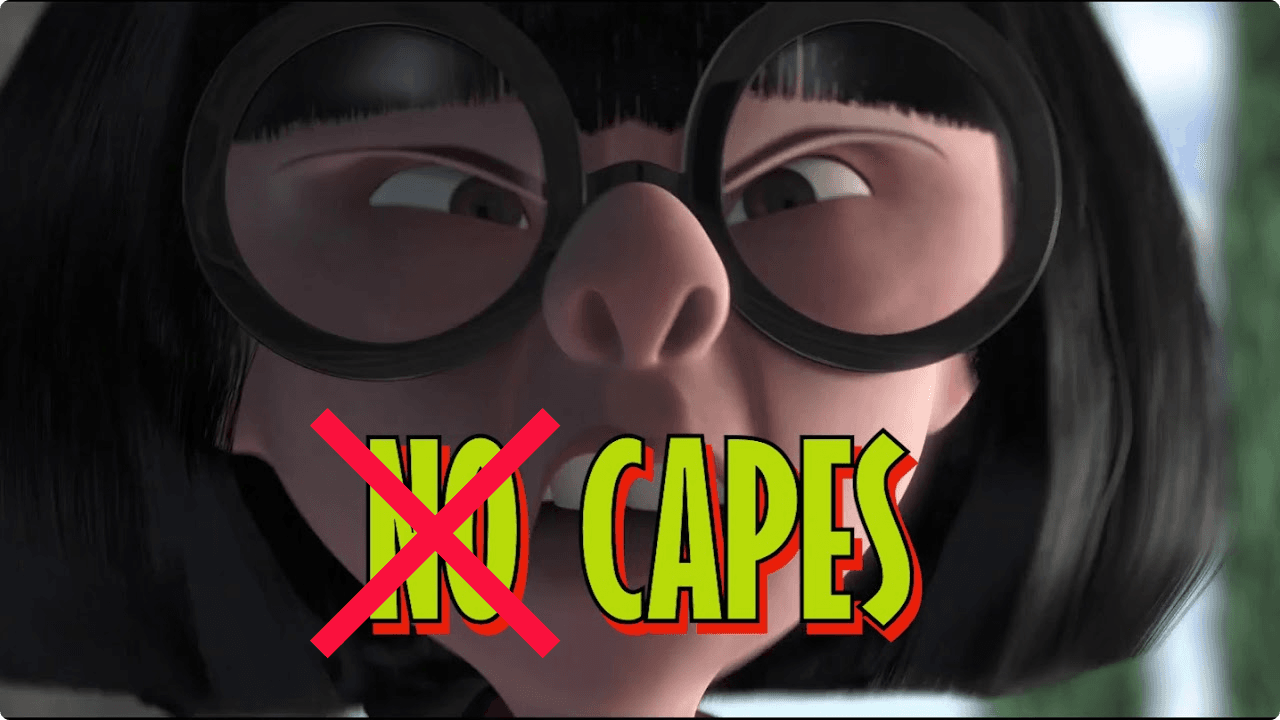
 Christopher R. RiceFeb 19, 2023
Christopher R. RiceFeb 19, 2023Sorry, Edna. YES, CAPES.

In Valheim, capes give you a slight boost for eating up an inventory slot early on, but later on become absolutely essential to have. We’re gonna talk about the game aspects of each cape…but we’re also going to talk about the real world attributes of such things, along with any historical or mythological standing they might have.
The Basics
A normal human sized cape (really a cloak in this context, because most capes don’t actually go below the belt) is approximately 3.5 square feet of material for the back torso, and about 1.575 square feet for the back of the legs to the knees. That means each cape is about 5.075 square feet for your typical Viking – which isn’t a whole lot, if we’re being honest.
But the cost of a thing isn’t always in the materials. In fact, it’s often in the knowledge the maker possesses – and this is one of those things. A respectable cape can offer protection from the weather, which is worth its weight in gold for most travelers. Medieval Dress and Textiles in Britain: A Multilingual Sourcebook suggests that a good cloak might be worth between 5% to 10% of a typical person’s labor in a given month.
Material and stitching would obviously influence this cost. An ermine-lined cape with heavy waterproofing on the outside, excess embroidery, etc. will cost up to 100 times more than a typical subject.
The Deer Hide Cape
The first cape you get is skin and bones (more or less), but it keeps the weather off you. In the game, it can be upgraded four times, each giving you a tiny bit more defense. Each upgrade costs increasingly more leather and bones. Its sprite tends to look a bit ragged, but is otherwise functional.
Of all the capes, this one is probably most like the kind that would actually be worn. Yes, I know wool is probably THE most common in reality, but for some reason, wool capes are not a thing in the game. Since an adult deer can give between 11 and 12 square feet of hide, each deer can supply about two capes. Buttons and pins can be made from the bones or horns and its sinew can be twisted to provide thread.
The Troll Hide Cape
This one is a bit odd and a tiny bit on the icky train. First, in Valheim, trolls are tool-users who carry gold, make lairs with stuff, etc. That means they are sapient. And that means your Viking is wearing people. “Who are you wearing this season, Valstagg?” “I think his name was [clears throat and roars].” Given that it’s a bit of a gameism, one of the interesting properties of troll hide capes is that they make you sneakier. I’m not sure how that was arrived at, but, errr, okay. It offers less defense than an amped up deer hide cape, but its bonus to sneaking can be VERY useful to certain play styles – even at the end of the game.
Since trolls are not real, we don’t have an exact comparison for them…or do we? An elephant is a similar size and you can get about 200 square foot of leather per adult animal. But that would mean we could get lots of troll hide for cloaks from a single beast and that’s not the case. Given that it offers a bonus to sneaking, my thoughts go to the softest, easiest to tan portion of the animal. If we assume 10% is the absolute limit for the good stuff, then each troll could give up to 20 square feet of usable leather – which is about right.
The Wolf Fur Cape
This is the one you’ll end up wearing for a while. It’s got the cool factor, it protects against the cold of the mountains, and it has a good defensive value. Of course, getting the materials to make one is hard – Valheim wolves are no joke. Given its resource costs, this one is a bit obscene to upgrade, but is more or less a good investment.
Mythologically speaking, a wolfskin had all sorts of interesting connotations in Norse mythology. First, wolves were a big deal – two wolves, Freki and Geri – were at Odin’s side. Moreover, berserkers just as often wore bearskin as they did wolfskin and there are a lot of indicators that the idea of transforming into a wolf (i.e., a werewolf) might have started because of these mythical badasses. One of the most feared beings in Norse mythology was the wolf-god Fenrir, birthed of Loki and the giantess Angrboda. Another was Garm, a wolf (or sometimes a dog) that guarded the gates of Hel; in many tales, he is more feared than even Fenrir.
So what about the real world? Well, remember we need about 5.075 square feet of fur and leather to make a cape of wolf hide. Each wolf has about 3 to 4 square feet of usable material. That means we need about two wolves per person so clothed. And maybe 3, since a useable head skin isn’t always guaranteed.
The Lox Fur Cape
Okay, I’mma just come out and say it: the lox are cool. They are a game critter unique to Valheim and they are big and fuzzy and I want one [so fluffy I’m gonna die meme]. They are some weird combination of reptile and mammal with thick coats that also provide a bit of protection at the cost of being heavy. Like wolf fur, they also protect against cold and are one of the best capes you can get in the game.
Lox don’t exist – but if they did, I think by their sprite size they are about twice the size of a buffalo. Since buffalo have between 33 to 45 square feet on its pelt there is about triple that on a lox (thank you square cube law). That means each lox is likely able to give 99 to 135 square feet per adult. Like the troll hide, it would be best to assume 10% is useable as good cape material. This means each lox can make about two capes.
The Linen Cape
Okay, this one is pretty easy and the most likely historical cape other than the hide one. Linen is fibers from the flax plant woven into cloth. It’s very durable – we actually have hundreds of hundred-year-old specimens from all over the world. In the game, it also protects against cold effects, is lighter than the lox cape, and almost as protective.
Flax plants have no typical amount of threads they can provide, but it seems each one is about 0.5 to 0.75 square feet, from what I could find, meaning you’ll need about 80 adult plants to make the material for a linen cape.
The Feather Cape
From a pure game standpoint, this is the best cape (so far). Screw the frost protection, gives us the floaty fally protection, precious. I cannot even begin to tell you how many times I have fallen off a mountain and just died. ARGH. But this thing? This thing is awesome. Doesn’t matter if you fall because you can glide. The Mistlands almost made me quit. It took the worst things about mountains and then added crazy powerful critters. But one of the folks I play with took pity on me, got me a cloak, and suddenly it was way, way less difficult. It was still hard, but it didn’t feel impossible after I got it.
Mythologically speaking, a fjaðrhamr (“feather cloak”) is owned by both the goddess Frigg and the goddess Freya. It’s been lent out to heroes and allies of the Asgard (notably, Loki) for all manner of tasks. That version actually let you fly and was sometimes thought to be made of falcon feathers.
Realistically, a cloak of feathers needs a leather or cloth backing so you can sew them into the fabric in layers, much like how you’d tile a roof. Each primary feather of a falcon is about 7.8 inches long and 1.25 inches wide. If we layer them about an inch from the quill, then we get about 1 square foot of coverage. But that’s not what the sprite looks like. It is DENSELY covered. So we divide coverage by ten. Since a falcon has ten such feathers, each falcon provides about 0.1 square feet needed. This assumes you’re killing the bird or waiting for shedding season. You could use other feathers if you want a less uniform look.
Final Thoughts
This is a simplistic, but fun look at what Valheim objects might look like in the real world. It’s probably not up to historical rigor because I didn’t dig too deep (especially regarding the flax), but it is interesting, don’t you think?
What other sorts of things might we look at from the game and convert over into a more historical, mythological, or realistic light?

Play on Haptic
Try for free


